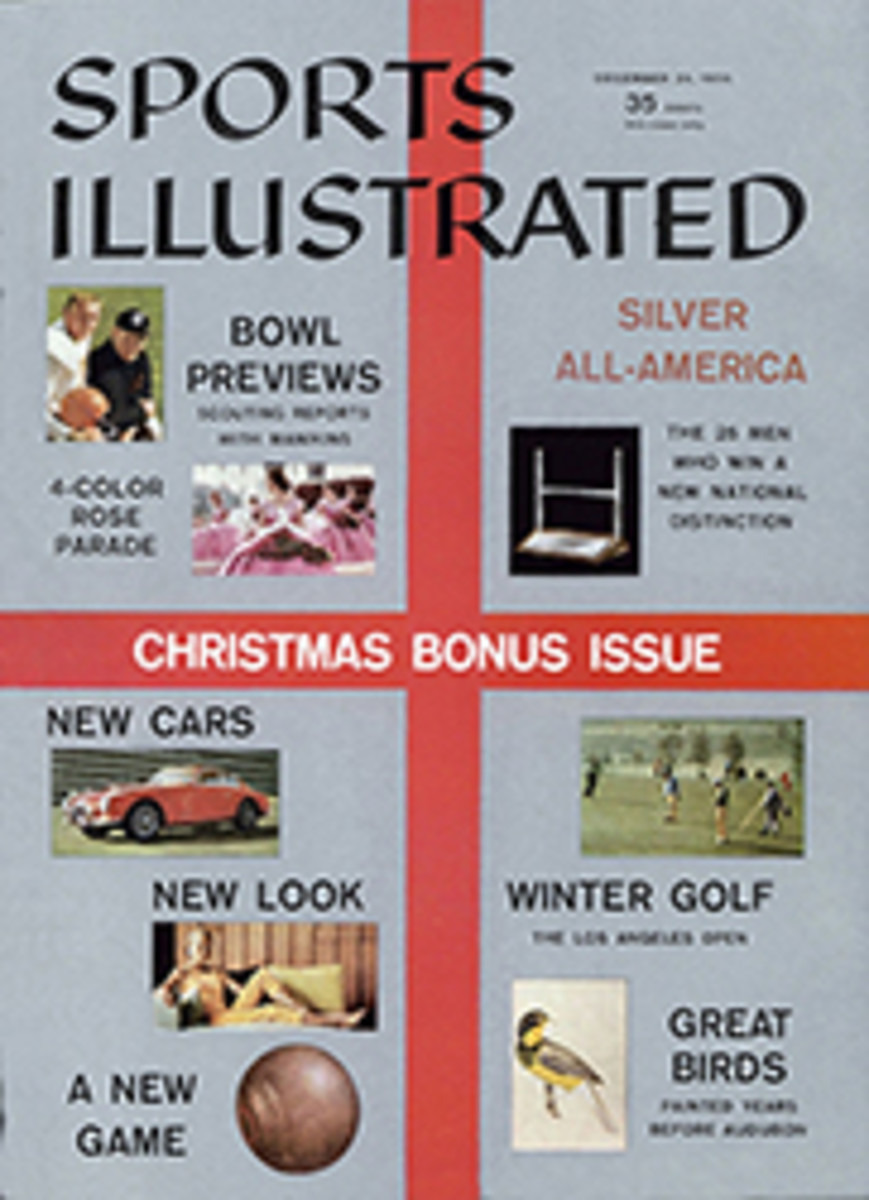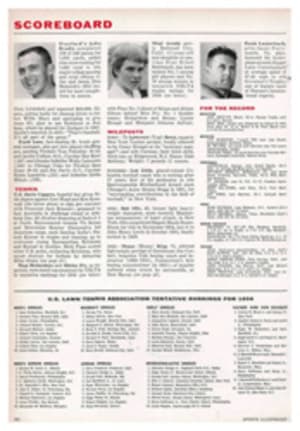
IT STARTED WITH FLOWERS
When Pasadena moves 8 million flowers from one end of town to the other on New Year's Day, more than a million people come to watch. About 45 million more stay home to watch this pageant on their television sets, for this is one of the most looked-at events in the U.S.
It started as a flower-throwing picnic among friends, but it has spread into a project so breathtaking that the whole town pants when it is over.
Thirty committees of Pasadena businessmen work on their Tournament of Roses parade, and all they ever get out of it is fun, and a chance to buy two Rose Bowl tickets at the regular price. There are 3,000 people who walk or ride in the parade, enough to populate a small town.
Seasoned amateurs run this show, the most famous single-day celebration in the world. For 51 weeks before the parade these businessmen have been planning, scheduling, screening, routing, listing, checking, conferring and setting it up. Somehow a football game got attached to the lighter events.
When the world lines up on Pasadena's curbs this coming January 1, 1957, this is what it will see:
Sixty floats—a fairyland in flowers, green-and-gold dragons, jet planes, ships; all riding on metal skeletons over truck beds shaped with chicken wire and plaster and plastic cocoons like those that cover the Navy's mothball fleet. Over that the pay load: flowers, decorated with pretty people in shiny clothes, bringing giants and knights and nursery rhymes to life.
"Every inch of every float must be covered with real flowers or plants," explains a committeeman. "We check that very carefully. Absolutely nothing artificial, all freshly cut."
Twenty of the best marching bands in the nation will deploy among the floats, blaring through town and trampling on fallen roses and lilies and orchids in the streets.
Two hundred horsemen and horsewomen are polishing silver now for this parade. Some of their saddled mounts are worth $50,000 on the hoof.
Sixty-seven parades have preceded the one that is now nearly ready to roll. They started soon after Dr. Charles Frederick Holder came home from Europe in 1888 and spoke a fateful sentence, something like this: "I saw a lovely thing in Rome. They called it the Battle of the Flowers. Why couldn't we...?"
He said it in the lounge of the Valley Hunt Club, a gathering place for wealthy and energetic Pasadenans and eastern socialites wintering there. By New Year's Day 1890 they had a little village frolic under way. Six years later the parade was so long and so famous that the Valley Hunt Club asked to be relieved of the big job of running it. Many of its members were active in forming the new Tournament of Roses Association. Today this nonprofit corporation has a year-round office and 1,500 members with a 40,000-man-hour effort focused on two hours of one day of the year. Out of this office come the ideas.
Somebody thought of having grand marshals. The honor has been handed to people like Vice-President Richard Nixon, former President Herbert Hoover, Chief Justice Earl Warren and Secretary of Defense Charles Wilson.
Somebody thought of having Rose Queens. Though they sit in one of the brightest spotlights in the world, few queens or princesses have tried for movie careers. These Pasadena schoolgirls are picked for poise, tact, brains and wear-well beauty, not glamour.
The fiercest excitement for many comes the night before the parade. In big sheds and Quonset huts around town, some 3,000 all-night workers spend New Year's Eve in a frantic race to get flowers glued or wired into place. They wait until the last desperate moment so their flowers will be fresh at parade time.
Tension tightens after daylight. Huge flowered monsters nuzzle each other in the assembly area, and their attendants run beside them patting final flowers into place. Everything surges and heaves for a while. Far ahead a band stiffens and steps off blaring, pulling the whole area taut. Pandemonium turns into a parade.
The mechanized flower gardens rumble up Orange Grove Avenue, past the reviewing stand, east on Colorado Boulevard, on through town and out to their halting points in Victory Park. Here they will draw another 500,000 visitors and tie up traffic for two days after the parade is over.
And Pasadena will send out a mechanized army of workers to gather the 50,000 pounds of rubbish that the visitors have left on the streets.
Gail Schueltge nervously hikes dress before boarding the city of Burbank's first-prize float, "Page One"
Early-morning crowd gets special treat as Rose princesses board the main float, Shown are Yvonne Flint, Sue Anderson, Lelia McEachern and Arnette Fredrickson
Bunny girls Betty Walker (left), Cathy Reynolds accompany Easter Parade float
THREE PHOTOS
MARK KAUFFMAN

